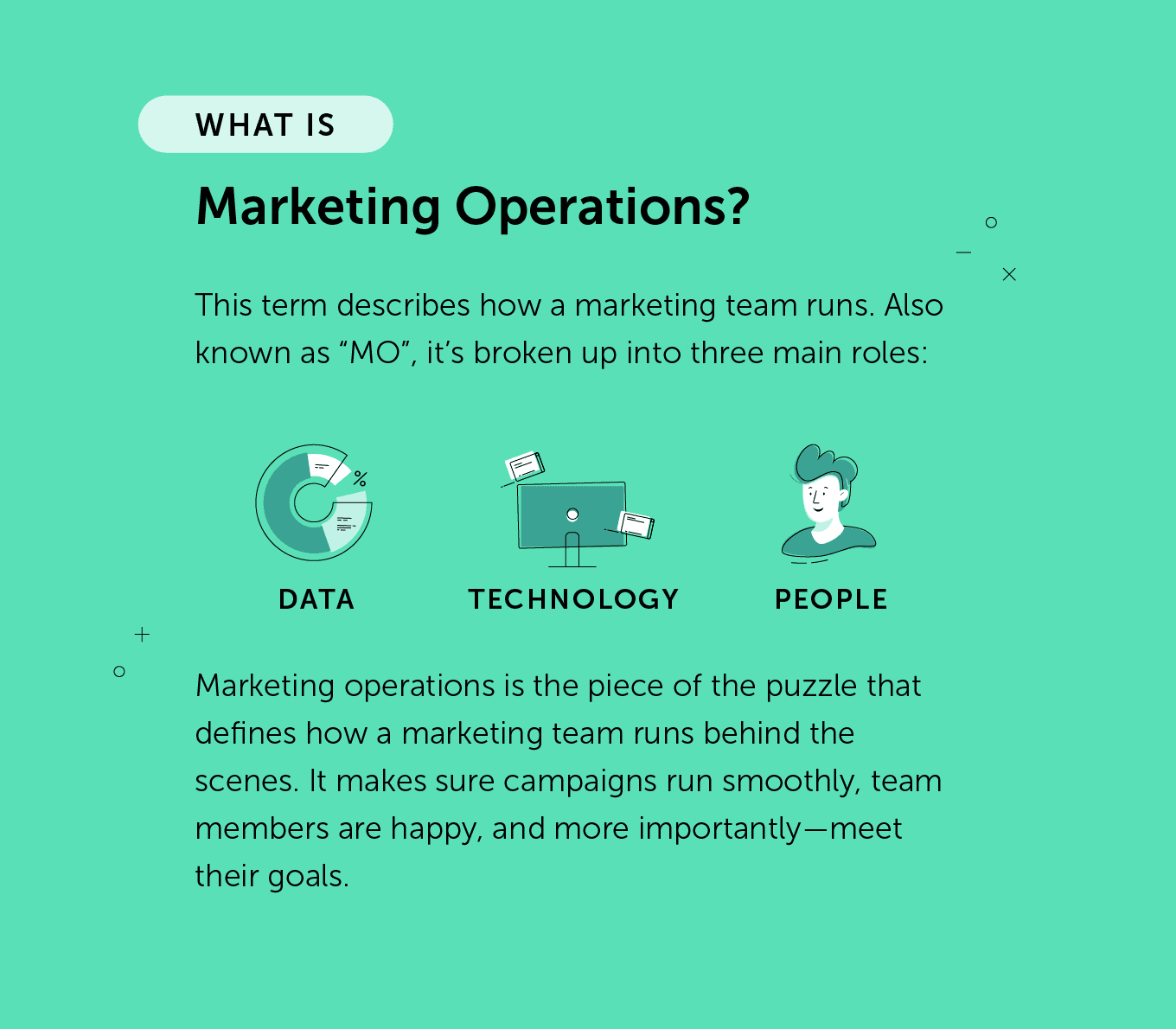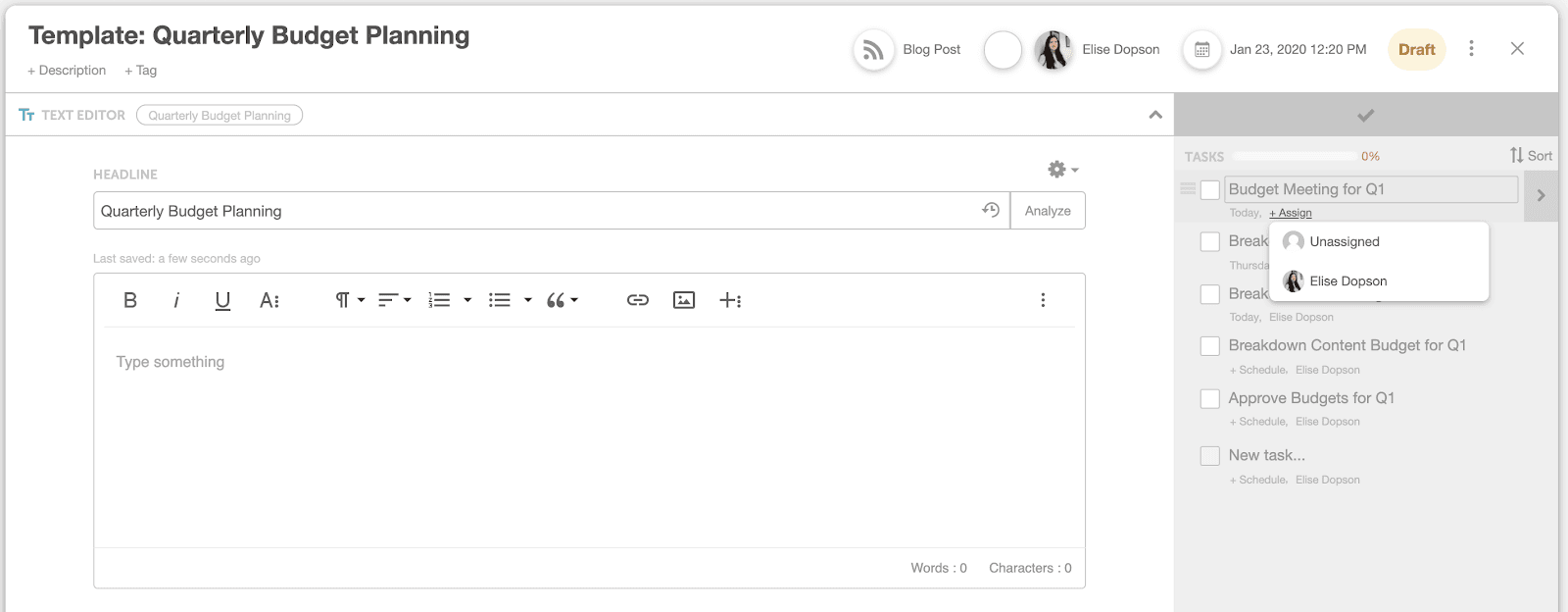Marketing Operations: The Start to Finish Guide for Busy Managers
15 minute read

Download Your Marketing Operations Templates
Putting this advice into practice will take some tools. Get started with some downloadable options in this kit:- Performance Review Question Template: Identify bottlenecks in marketing workflows by helping team members identify performance problems.
- Performance Management Checklist: Never miss another important step when it comes to maximizing your team's potential.
- Marketing Project Checklist Template: Build consistent processes and workflows for every marketing project.
- Marketing Project Management Plan Template: Plan and organize a consistent approach to managing projects.
- Marketing Project Management Calendar Template: Visualize deadlines and organize projects in one place — with full visibility for your entire team.
Table of Contents
- What is Marketing Operations?
- What Does a Marketing Operations Manager Do?
- Why is Marketing Operations Important?
- 5 Marketing Operations Processes You Need
- How to Implement a Marketing Operations Process
- Operationalizing Your Marketing Processes
- Consider Implementing an Agile Approach
- Ready to Get Started?
What is Marketing Operations?
Wondering exactly what “marketing operations” means? This term describes how a marketing team runs. Also known as “MO,” it’s broken up into three main roles:- Data
- Technology
- People

What Does a Marketing Operations Manager Do?
Ready for some obvious news? The person handling this part of a marketing strategy is called a marketing operations manager. This person handles the HR of their team, marketing strategy, and toolstack. It’s their job to make sure they’ve got a strong team who is equipped with the best technology and training to create ground-breaking marketing campaigns.Recommended Reading: 16 Awesome Agile Marketing Resources to Train Your Busy Team
A marketing operation manager’s main goal is to optimize the entire marketing process — from budgeting for each campaign and managing assets, to optimizing ROI and sending MQLs to sales. Lower-level marketing staff will report to them. They typically report to a CMO or CEO on behalf of the entire marketing department. This video, from Informatica, does an excellent job breaking down what their work entails. https://www.youtube.com/watch?v=azYKE6gX5yo
Why is Marketing Operations Important?
Now we’re clear on what marketing operations actually is, so let’s move on to the juicy part: why it’s important. We’ve already mentioned that a marketing operations manager wants to improve the output of their marketing team. That’s why one of their main priorities is to work on boosting staff productivity. [Tweet "A main priority for a marketing operations manager is to boost staff productivity."] In practice, this could be a social media marketer complaining that they spend too much time doing a low-output task. That time-consuming task might be pulling their focus away from something more important or of higher value, which impacts how much work they get done. In turn, the marketing operations manager would look for tools to do it for them. Before you brush this off as a niche example, remember that modern technology could automate 45% of the activities people are paid to perform. There’s always a task you can cut; it’s a marketing operations manager’s job to spot it.

5 Marketing Operations Processes You Need
Now you know that marketing operations is a key part of any marketing department, you might be questioning which processes your manager will handle. Here are five processes you need to create from the get-go:1. Budget Management
Did you know that the average company spends 26% of their annual revenue on marketing? Sure, your marketing operations manager will need a process to define how much of your revenue will be assigned to marketing efforts. They’ll also need to break down how that budget is proportioned to various channels or departments, such as:- Email marketing
- Social advertising
- Content creation
2. Lead Management
Marketing teams shouldn’t work in silos. It’s your marketing operation manager’s job to make sure that the leads you’re driving from marketing are converting into sales-qualified leads. It’s harder than you might think; just 13% of MQLs convert to SQLs.
3. Reporting and Analytics
Reporting has gained a reputation for being boring, but while your creative team might not want to digest data, you won’t know whether your strategy is working without them. A marketing operations manager needs a process for creating these reports, which includes:- Who creates the reports?
- How often?
- What should they report on?
- Who needs to read them?
- How are they made?
4. Asset management
Every marketing team has assets. This usually includes content (i.e. blog posts, videos, and podcasts). [Tweet "Every marketing team has assets. This usually includes content (i.e. blog posts, videos, and podcasts)."] A marketing operations manager needs to control everything related to these assets, including their:- Creation
- Licensing
- Usage
5. Data Management
It’s no secret that we have more data than ever before; 90% of the world’s data was created within two years. With so much data available, it can quickly become overwhelming. Every dashboard has a set of metrics, and each new tool introduces you to a bunch of new metrics. That’s why your marketing operations team needs a process that defines:- How you’ll collect data.
- What you’ll collect.
- How you’ll use it.
Recommended Reading: Marketing Request Forms: How to Create One Your Team Will Actually Use
How to Implement a Marketing Operations Process
Creating a marketing operations process sounds easier than it looks. You’ll need to think about how your team are involved, the frequency of each process, and the tools you’ll need to make them happen.Recommended Reading: The Best Marketing Operations Strategy to Help Overloaded Marketing Managers
The best news? There is a simple process you can use to get started.
1. Use a Team Management Dashboard
Earlier, we discussed how a marketing operations manager will define tasks for their team. You don’t have to remember who is responsible for each, individual part of the process you’re creating, though. A team management dashboard allows your entire department to see who is responsible for what and check that tasks in the workflow are being completed. Let’s put that into practice using the asset management process. The following team members have different responsibilities:- Ellie takes photographs.
- Lucy will get them copyrighted.
- Matt will plan to use them in social media content.
- Jason will proof and publish them.

2. Create Templates For Each Task
Think of how long you spend creating the same tasks. It’s a tedious job, right? Remember, a marketing operations manager needs to find smart ways to cut time and improve productivity — not just for their staff, but themselves, too! [Tweet "A marketing operations manager needs to find smart ways to cut time and improve productivity — not just for their staff, but themselves, too!"] You can do that by creating templates for each task in your process. If you’re using CoSchedule, create a new project to use as your template. Add the tasks that need to be completed to tick-off that entire project, and click Assign to give a team member control over that task.
Recommended Reading: The Best Way to Plan and Organize Marketing Tasks With Checklists
3. Monitor Team Performance Reports
We’ve already mentioned that a marketing operations manager's goal is to improve efficiency in their team. It’s their job to make sure they spend time on high-growth tasks and maximize your overall marketing ROI. How can you know whether or not you’re doing that? The simple answer: Performance reports, which break down your team’s activities. They’ll show you answers to questions such as:- Are they meeting deadlines?
- How much time are they spending on each task?
- Is there a tool you can use to cut time/improve performance?


4. Choose Tools That Integrate Well Together
You don’t need to search for tools that wipe out complete tasks that your team does. Some tasks, like private messages with potential leads, need a human touch. That’s not to say you can’t use technology to cut down the time they spend writing them or do a better job at it. Take email subscriptions, for example. We all want more high-quality leads on our list, right? People who fit that bill might be those already engaging with your SMS marketing campaigns. Send a message asking whether they’d like to sign-up to your list, using an automation to get them added. There’s no waiting for your customer, nor extra admin work for your team. They’re on your email list within a matter of seconds. If you’re using CoSchedule to manage your marketing strategy, you have access to hundreds of similar automations for each channel, including:- WordPress
- Social media
- Email service providers (e.g. MailChimp, Constant Contact, Active Campaign, and Campaign Monitor)

Operationalizing Your Marketing Processes
Efficient and effective processes are one of the key components of marketing operations. A successful marketing team doesn’t just set it and forget it, they are constantly improving and tailoring best practices.Recommended Reading: 8 Marketing Project Management Skills You Need to Lead a Successful Team
Start by planning and documenting your workflows. Documenting your workflows means that everyone knows the correct order of operations, when tasks are due, and where their contributions fit into the project’s timeline. They are essential for completing work on time, every time. A documented workflow also means that you can spend more time doing meaningful work and less time following-up with every person at every stage of a marketing project. Here’s how to do it:
- Step 1: Determine each team member’s role for each type of project you execute regularly.
- Step 2: Map out each task that needs to be completed.
- Step 3: Next, assign the task and determine the length of time needed to complete each task.
- Step 4: Work back from there to determine the necessary project length and attach task due dates for each step in the workflow.
- Generate ideas: Strategist – due 30 days before launch
- Recruit guest: Strategist – Due 25 days before launch
- Create talking points: Strategist – Due 18 days before launch
- Design slide deck: Designer – Due 17 days before launch
- Include in drip campaign: Marketing Automation – Due 14 days before launch
- Approve slide deck: Strategist – Due 12 days before launch
- Schedule social promotion: Writer/Social Strategist – 10 days before launch
- Test run-through: Guest and Host – 1 day before launch
Consider Implementing an Agile Approach
Agile refers to a flexible marketing approach in which teams identify high-value projects, break those project down into smaller deliverables, measure their impact, and then iterate on the results to incrementally improve. Agile Marketing provides marketing teams a set process for running most marketing campaigns. Here is a very high-level explanation of how to get started applying this methodology with your team:Step 1: Define the Project
Before you get started, make sure that the project is a good fit for an Agile approach. Agile is best fit for big projects that can easily be divided up into smaller pieces. Think website redesigns and large marketing campaigns.Step 2: Sprint Planning Meeting
Next, schedule the sprint planning meeting. Everyone who will be working on the project will attend this meeting. Discuss each task and deliverable for the project.Step 3: Task Breakdown
Each task within the project needs to be broken down. This should be fairly granular. For example, writing, proofing, and approving the blog post could be separate tasks. At this time, the head of the project (most likely the marketing manager) will ask info regarding how much time each task will take to accomplish. These tasks could be visualized using a Kanban board.
Step 4: Daily Scrums
Once you have all your tasks planned, teams start working on their tasks. To keep track of your project, you will begin having daily check-in meetings. These are extremely short and should only take 5-10 minutes.
- What did you do yesterday?
- What will you do today?
- Any roadblocks?
Ready to Get Started?
Marketing operations is a key part of any company. Without it, you’ll spend time on the wrong things — focusing on low-growth activities that waste everyone’s time. The simplest way to get started is to list the processes your team follows. Then, create a marketing operations process for each task using the guide above. You’ll soon start to see how much work you get done when one-off tasks and confusion are gone!Recommended Reading: Marketing Request Forms: How to Create One Your Team Will Actually Use
This post was originally published on Feb. 19, 2020. It was updated and republished on July 9, 2020. Leah Dekrey contributed writing to this post.
The post Marketing Operations: The Start to Finish Guide for Busy Managers appeared first on CoSchedule Blog.

Post a Comment